Multimodal multiphasic pre-operative image-based deep-learning predicts hepatocellular carcinoma outcomes after curative surgery
IF 12.9
1区 医学
Q1 GASTROENTEROLOGY & HEPATOLOGY
引用次数: 0
Abstract
Background: Hepatocellular carcinoma (HCC) recurrence frequently occurs after curative surgery. Histological microvascular-invasion (MVI) predicts recurrence but cannot provide pre-operative prognostication, whereas clinical prediction scores have variable performances. Methods: Recurr-NET, a multimodal multiphasic residual-network random survival forest deep-learning model incorporating pre-operative CT and clinical parameters, was developed to predict HCC recurrence. Pre-operative triphasic CT scans were retrieved from patients with resected histology-confirmed HCC from four centers in Hong Kong (Internal-cohort). The internal-cohort was randomly divided in an 8:2 ratio into training and internal-validation. External-testing was performed in an independent cohort from Taiwan. Results: Among 1231 patients (Age 62.4, 83.1% male, 86.8% viral hepatitis, median follow-up 65.1 months), cumulative HCC recurrence at years 2 and 5 were 41.8% and 56.4% respectively. Recurr-NET achieved excellent accuracy in predicting recurrence from years 1-5 (Internal cohort AUROC 0.770-0.857; External AUROC 0.758-0.798), significantly out-performing MVI (Internal AUROC 0.518-0.590; External AUROC 0.557-0.615) and multiple clinical risk scores (ERASL-PRE, ERASL-POST, DFT, and Shim scores) (Internal AUROC 0.523-0.587, External AUROC: 0.524-0.620) respectively (all基于图像的多模式多期术前深度学习预测肝细胞癌治愈性手术后的预后
背景:肝细胞癌(HCC)在根治性手术后经常复发。组织学微血管侵袭(MVI)预测复发,但不能提供术前预后,而临床预测评分有不同的表现。方法:Recurr-NET是一种结合术前CT和临床参数的多模态多相剩余网络随机生存森林深度学习模型,用于预测HCC复发。术前三期CT扫描从香港四个中心的切除组织学证实的HCC患者中检索(内部队列)。内部队列按8:2的比例随机分为训练组和内部验证组。外部检验是在台湾的独立队列中进行的。结果:1231例患者中(年龄62.4岁,男性83.1%,病毒性肝炎86.8%,中位随访65.1个月),第2年和第5年HCC累计复发率分别为41.8%和56.4%。Recurr-NET预测1-5年复发的准确度很高(内部队列AUROC 0.770-0.857;外部AUROC 0.758-0.798),显著优于MVI(内部AUROC 0.518-0.590;外部AUROC 0.557-0.615)和多重临床风险评分(ERASL-PRE、ERASL-POST、DFT和Shim评分)(内部AUROC 0.523-0.587,外部AUROC: 0.524-0.620)(均为0.001)。在第2年复发风险分层方面,Recurr-NET优于MVI(内部:72.5% vs. MVI的50.0%;外部:65.3% vs. MVI 46.6%)和第5年(内部:86.4% vs. MVI 62.5%;外部:81.4% vs. 63.8%的MVI)(所有p<;0.001)。在肝脏相关死亡率和全因死亡率分层方面,Recurr-NET也优于MVI (p < 0.001)。在亚组分析中,Recurr-NET的表现仍然稳健。结论:Recurr-NET准确预测HCC复发,分别优于MVI评分和临床预测评分,突出了其在术前预测中的潜力。
本文章由计算机程序翻译,如有差异,请以英文原文为准。
求助全文
约1分钟内获得全文
求助全文
来源期刊

Hepatology
医学-胃肠肝病学
CiteScore
27.50
自引率
3.70%
发文量
609
审稿时长
1 months
期刊介绍:
HEPATOLOGY is recognized as the leading publication in the field of liver disease. It features original, peer-reviewed articles covering various aspects of liver structure, function, and disease. The journal's distinguished Editorial Board carefully selects the best articles each month, focusing on topics including immunology, chronic hepatitis, viral hepatitis, cirrhosis, genetic and metabolic liver diseases, liver cancer, and drug metabolism.
 求助内容:
求助内容: 应助结果提醒方式:
应助结果提醒方式:


